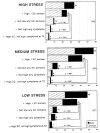Resilience is not a unidimensional construct: Insights from a prospective study of inner-city adolescents
- PMID: 25722542
- PMCID: PMC4339070
- DOI: 10.1017/S0954579400006246
Resilience is not a unidimensional construct: Insights from a prospective study of inner-city adolescents
Abstract
The maintenance of high social competence despite stress was examined in a 6-month prospective study of 138 inner-city ninth-grade students. The purpose was to provide a replication and extension of findings derived from previous cross-sectional research involving a comparable sample of children. Specifically, goals were to examine the extent to which high-stress children with superior functioning on one or more aspects of school-based social competence could evade significant difficulties in (a) other spheres of competence at school and (b) emotional adjustment. Measurements of stress were based on uncontrollable negative life events. Competence was assessed via behavioral indices including school grades, teacher ratings, and peer ratings, and emotional distress was measured via self-reports. Results indicated that high-stress children who showed impressive behavioral competence were highly vulnerable to emotional distress over time. Furthermore, almost 85% of the high-stress children who seemed resilient based on at least one domain of social competence at Time 1 had significant difficulties in one or more domains examined when assessed at both Time 1 and Time 2. Findings are discussed in terms of conceptual and empirical issues in resilience research.
Figures


References
-
- Achenbach TM, Edelbrock C. Manual for the Youth Self-Report and Profile. Department of Psychiatry, University of Vermont; Burlington: 1987.
-
- Boyle MH, Jones SC. Selecting measures of emotional and behavioral disorders of childhood for use in general populations. Journal of Child Psychology and Psychiatry. 1985;26:137–159. - PubMed
-
- Brand AH, Johnson JH. Note on the reliability of the Life Events Checklist. Psychological Reports. 1982;50:1274.
-
- Cohen J, Cohen P. Applied multiple regression/correlation analysis for the behavioral sciences. Erlbaum; Hillsdale, NJ: 1975.
-
- Cohen L, Burt C, Bjorck J. Life stress and adjustment: Effects of life events experienced by young adolescents and their parents. Developmental Psychology. 1987;23:583–592.
Grants and funding
LinkOut - more resources
Full Text Sources
